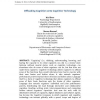212 search results - page 23 / 43 » Body degree zero |
CVPR
2010
IEEE
14 years 4 months ago
2010
IEEE
While the problem of tracking 3D human motion has been widely studied, most approaches have assumed that the person is isolated and not interacting with the environment. Environme...
CVPR
1996
IEEE
13 years 11 months ago
1996
IEEE
We present a vision system for the 3-D modelbased tracking of unconstrained human movement. Using image sequences acquired simultaneously from multiple views, we recover the 3-D b...
SIGGRAPH
1996
ACM
13 years 11 months ago
1996
ACM
Current linear-time simulation methods for articulated figures are based exclusively on reduced-coordinate formulations. This paper describes a general, non-iterative linear-time ...
CORR
2008
Springer
13 years 7 months ago
2008
Springer
: "Cognizing" (i.e., thinking, understanding, knowing, and having the capacity to do what cognizers can do) is a mental state. Systems without mental states, such as cogn...
ICASSP
2011
IEEE
12 years 11 months ago
2011
IEEE
Speech inversion is a way of estimating articulatory trajectories or vocal tract configurations from the acoustic speech signal. Traditionally, articulator flesh-point or pellet t...

